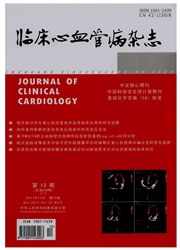

 中文摘要:
中文摘要:
目的:评价枝化状聚乙二醇(PEG)交联去细胞猪主动脉瓣的生物相容性。方法:依据GB/T16886.6-1997标准,利用直接接触法和浸提液接触法(间接接触)检测所制备的组织工程化心脏瓣膜材料的致凝血性能、致溶血性能,采用AlamarBlue?细胞活力检测法和Annexin V凋亡检测法评价材料的细胞毒性,并应用形态学方法检测瓣膜表面细胞粘附增殖情况,以新鲜天然瓣膜和去细胞瓣膜作为对照。结果:新型材料不会明显刺激血小板引起其粘附、激活(与天然瓣膜对比,P〉0.5)。材料接触对凝血功能(INR,APTT)无显著影响。材料直接或间接溶血率均符合生物材料国家标准。AlamarBlue?法检测显示,与材料直接或间接接触对细胞增殖无显著影响,间接接触不增加细胞凋亡概率(P〉0.1)。细胞接种于材料表面后增殖迅速,形态正常,扫描电镜示细胞连接致密,呈单层排列覆盖材料。结论:枝化状PEG交联去细胞猪主动脉瓣的离体生物相容性达到GB/T16886.6-1997标准,是一种有潜力的组织工程化心脏瓣膜替代材料。
 英文摘要:
英文摘要:
Objective:To evaluate the biocompatibility of polyethylene glycol(PEG)cross-linked decellularized porcine aortic valve leaflets which knew as "novel tissue engineering heart valve(TEHV)material".Method: According to GB/T16886.6-1997standard,the direct contact method and the extraction liquid contact(indirect contact)method were adopted to test the biological properties of the TEHV material such as hemostasis and hemolytic properties,while the AlamarBlue?cell vitality assay and Annexin V apoptosis assay were also used to evaluate the cytotoxicity of the material.Adhesion and proliferation of cells on the material surface were assessed with morphological method.Fresh porcine valves and decellularized valves were chosen as control.Result:The novel material did not activate platelet and promote platelet adhesion obviously(compared with fresh valve,P0.5). Direct and indirect contact with the material had no significant impacts on blood coagulation(INR,APTT).Direct and indirect contact hemolysis rate of the material conformed to the state standards.AlamarBlue?assay showed that direct or indirect contact with material had no significant influences on cell proliferation.Indirect contact didn′t cause apoptosis rate increase(P0.1).After incubation,the cell proliferated rapidly with normal form on the material surface,scanning electron microscopy(SEM)proved the material surface was covered by a monolayer of cells which connected tightly.Conclusion:PEG cross-linked decellularized porcine aortic valve shows great in vitro biocompatibility conforming to GB/T16886.6-1997state standard and could be a promising novel material for TEHV or biological heart valve manufacture.
 同期刊论文项目
同期刊论文项目
 同项目期刊论文
同项目期刊论文
 Pioglitazone attenuates progression of aortic valve calcification via down-regulating receptor for a
Pioglitazone attenuates progression of aortic valve calcification via down-regulating receptor for a Gene Transfer of the S24F Regulated on Activation Normal T-Cell Expressed and Secreted-Chemokine Lig
Gene Transfer of the S24F Regulated on Activation Normal T-Cell Expressed and Secreted-Chemokine Lig Application of decellularized scaffold combined with loaded nanoparticles for heart valve tissue eng
Application of decellularized scaffold combined with loaded nanoparticles for heart valve tissue eng 期刊信息
期刊信息
